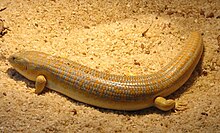Schneider's skink
| Eumeces schneideri | |
|---|---|

| |
| Scientific classification | |
| Kingdom: | |
| Phylum: | |
| Subphylum: | |
| Class: | |
| Order: | |
| Suborder: | |
| Infraorder: | |
| Family: | |
| Genus: | |
| Species: | E. schneideri
|
| Binomial name | |
| Eumeces schneideri | |
| Synonyms | |
| |
Eumeces schneideri, commonly known as Schneider's skink or the Berber skink, is a species of skink endemic to Central Asia, Western Asia, and North Africa.
Etymology
Both the specific name, schneideri, and one of the common names, Schneider's skink, are in honor of German zoologist, Johann Gottlob Theaenus Schneider.[2]
Description
Head moderate; snout short, obtuse. Nasal rather large, usually divided, in contact with the two anterior upper labials; no postnasal; 5 supraoculars, the three anterior in contact with the frontal; parietals entirely separated by the interparietal; 4 or 5 pairs of nuchals; ear-opening rather large, with 4 or 5 long pointed lobules anteriorly; 2 azygos postmentals. 22 to 28 scales round the middle of the body, perfectly smooth, the laterals smallest, those of the two median dorsal series very broad and larger than the ventrals. The length of the hind limb is contained 2.5 to 3 times in the length from snout to vent. When pressed against the body, the limbs just meet or fail to meet. A series of transversely enlarged subcaudals.[3]
Olive-grey or brownish above, uniform or with irregular golden-yellow spots or longitudinal streaks; a yellowish lateral streak, extending from below the eye to the hind limb, is constant; lower surfaces yellowish white.[3]
Size: from snout to vent, 16.5 cm (6.5 inches); plus tail, 20 cm (8 inches).[3]
Subspecies
Five subspecies are recognized, including the nominotypical subspecies.[1]
- Eumeces schneideri barani Kumlutas et al., 2007
- Eumeces schneideri pavimentatus (I. Geoffroy Saint-Hilaire, 1827)
- Eumeces schneideri princeps (Eichwald, 1839)
- Eumeces schneideri schneideri (Daudin, 1802)
- Eumeces schneideri zarudnyi Nikolsky, 1900
Nota bene: A trinomial authority in parentheses indicates that the subspecies was originally described in a genus other than Eumeces.
Geographic distribution
Eastern Algeria, Tunisia, Libya, Egypt, Sinai, Israel, Cyprus, Turkey, western Syria, Lebanon, Jordan, Iran (Kavir desert), Iraq, Saudi Arabia, Transcaucasia, Russia (Dagestan), Turkmenistan, Uzbekistan, Tajikistan, eastern Georgia, southern Armenia, Azerbaijan, Asia Minor, Afghanistan, northern Pakistan, northwestern India.
- Subspecies E. s. barani: Turkey (Anatolia).
- Subspecies E. s. pavimentatus: Jordan, Lebanon, Syria
- Subspecies E. s. princeps: Armenia, Azerbaijan, Caucasus
- Subspecies E. s. zarudnyi: southeastern Iranian Plateau in Kerman Province and Sistan and Baluchestan Province, Iran; Helmand Basin and southern desert regions of Afghanistan; Baluchistan and Mekran Coast of Pakistan. Type locality: Bazman, Iran (restricted by Taylor, 1935).[1]
References
- ^ a b c d The Reptile Database. www.reptile-database.org.
- ^ Beolens B, Watkins M, Grayson M. 2011. The Eponym Dictionary of Reptiles. Baltimore: Johns Hopkins University Press. xiii + 296 pp. ISBN 978-1-4214-0135-5. (Eumeces schneideri, p. 237).
- ^ a b c Boulenger GA. 1890. The Fauna of British India, Including Ceylon and Burma. Reptilia and Batrachia. London: Secretary of State for India in Council. (Taylor and Francis, printers). xviii + 541 pp. (Eumeces schneideri, pp. 219-220).
Further reading
- Caputo V, Odierna G, Aprea G, Capriglione T. 1993. Eumeces algeriensis - a full species of the Eumeces schneiderii group (Scincidae) - karyological and morphological evidence. Amphibia-Reptilia 14 (2): 187-193.
- Göçmen, Bayram; Asaf Senol and Ahmet Mermer. 2002. A new record of Schneider's Skink, Eumeces schneideri Daudin, 1802 (Sauria: Scincidae) from Cyprus. Zoology of the Middle East 27: 19-22.
- Daudin FM. 1802. Histoire Naturelle, Générale et Particulière des Reptiles; Ouvrage faisant suite à l'Histoire Naturelle gènèrale et particulière, composée par Leclerc de Buffon; et rédigée par C.S. Sonnini, membre de plusieurs sociétés savantes. Tome quatrième [Volume 4]. Paris: F. Dufart. 397 pp. ("Scincus Schneiderii [sic]", p. 291).
- Griffith H, Ngo A, Murphy RW. 2000. A cladistic evaluation of the cosmopolitan genus Eumeces Wiegmann (Reptilia, Squamata, Scincidae). Russ. J. Herpetol. 7 (1): 1-16.
- Mertens, Robert. 1920. "Über die geographischen Formen von Eumeces schneideri Daudin". Senckenbergiana 2 (6): 176-179.
- Mertens, Robert. 1924. "Dritte Mitteilung über die Rassen der Glattechse Eumeces schneiderii". Senckenbergiana 27: 53-62. (1946?)
- Mertens, Robert. 1924. "Herpetologische Mitteilungen: V. Zweiter Beitrag zur Kenntnis der geographischen Formen von Eumeces schneiderii Daudin". Senckenbergiana 6: 182-184.
- Smith MA. 1935. The Fauna of British India, Including Ceylon and Burma. Reptilia and Amphibia. Vol. II.—Sauria. London: Secretary of State for India in Council. (Taylor and Francis, printers). xiii + 440 pp. + Plate I + 2 maps. (Eumeces schneideri, pp. 341–342).
- Taylor EH. 1936 [1935]. A taxonomic study of the cosmopolitan lizards of the genus Eumeces with an account of the distribution and relationship of its species. Univ. Kansas Sci. Bull. 23 (14): 1-643.
External links
- Eumeces schneideri at the Reptarium.cz Reptile Database
- http://itgmv1.fzk.de/www/itg/uetz/herp/photos/Novoeumeces_schneiderii.jpg
- Eumeces schneideri at The Checklist of Armenia's Amphibians and Reptiles at Tadevosyan's Herpetological Resources. Accessed 30 March 2007.
- Picture of Eumeces schneideri
- Picture of Eumeces algeriensis
- Captive care
